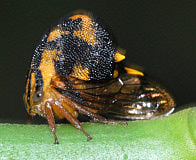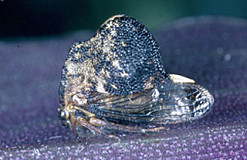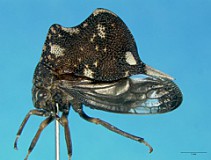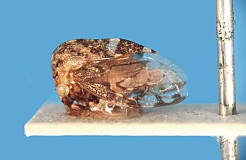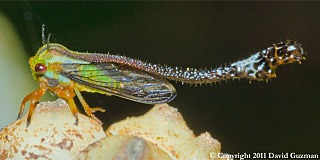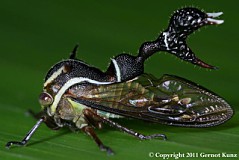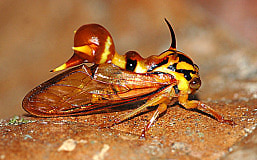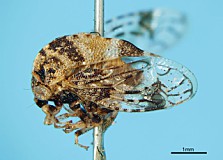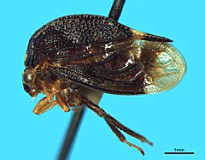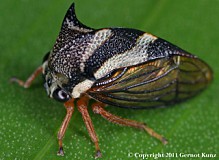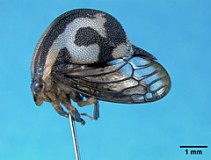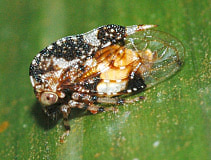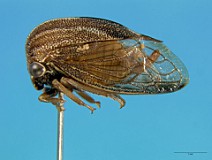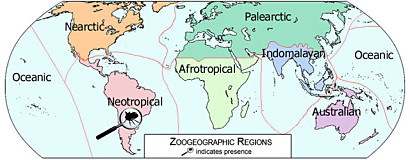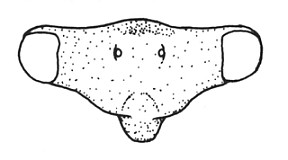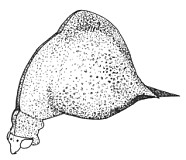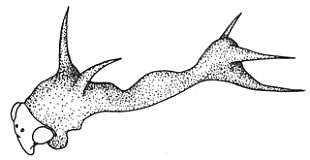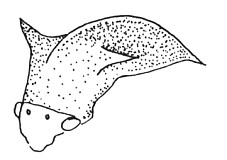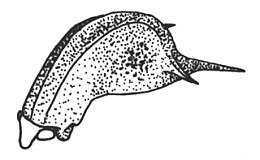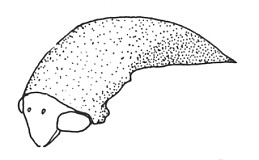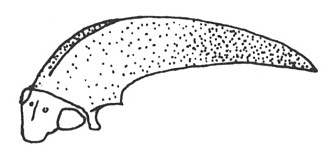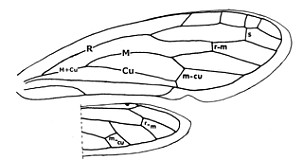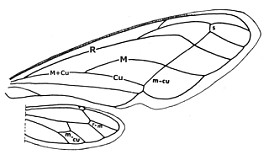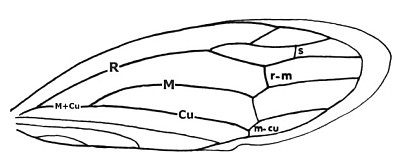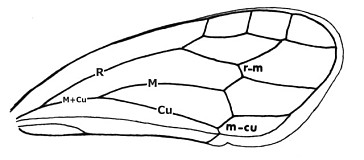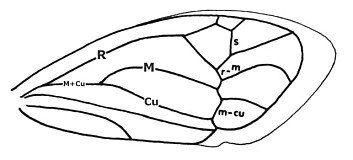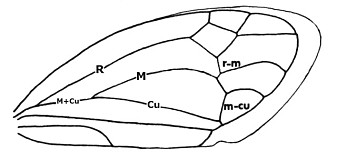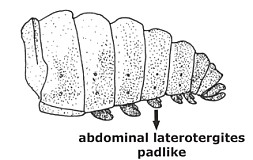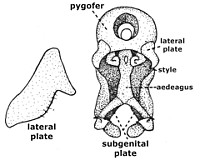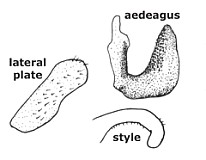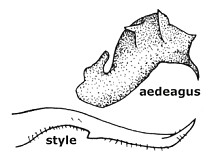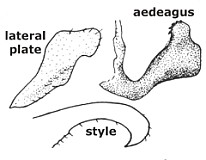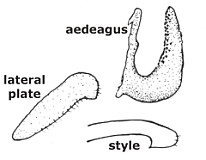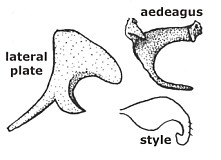Amyot and Serville 1843a
Goding 1926e
Haupt 1929c
Richter 1955a
Metcalf and Wade 1965a
Deitz 1975a
Sakakibara and Laroca 1975a
Boulard 1983a
Strümpel 1988b
Creão-Duarte and Sakakibara 1993a (dated 1992)
McKamey 1998a
Dietrich, McKamey, and Deitz 2001a
Cryan, Wiegmann, Deitz, Dietrich, and Whiting 2004a
Godoy, Miranda, and Nishida 2006a
Evangelitsa, Sakakibara, Cryan, and Urban 2017a
Animalia → Arthropoda → Insecta → Pterygota → Hemiptera → Auchenorrhyncha → Cicadomorpha → Membracoidea → Membracidae
Heteronotinae Goding, 1926
Selected references
Overview
Among treehoppers, the Neotropical subfamily Heteronotinae displays extreme diversity in pronotal shapes. In species of the genus Heteronotus the pronotum is a highly developed structure with horns and spines that mimics ants and wasps. On the other extreme, Rhexia species have a scooped-shaped pronotum that extends over the insect’s back like a shield and varies in color pattern, often making these treehoppers resemble lady bugs or other kinds of beetles. Heteronotines are characterized by having: the scutellum concealed by the pronotum; the tibiae slender; the forewings entirely exposed in repose with 1 r-m and 1 m-cu crossvein, and females with second valvulae serrated distally.
Taxon history
The valid name for this subfamily is Heteronotinae Goding 1926 (1843) , with the tribe Heteronotini Goding 1926 (1843) (Deitz 1975a). See the tribe Heteronotini for a discussion of the older family group names Combophorides Amyot and Serville 1843, and Heniconotini Goding, 1892.
Taxon images
Heteronotinae
Acoustic calls
[listen] Heteronotus (Membracidae: Heteronotinae: Heteronotini). Copyright © 2008, by Reginald B. Cocroft.
Distribution
Neotropical region: recorded from Argentina (Smiliorachis proxima Berg) north to Neotropical Mexico (Dysyncritus intectus Fowler).
Diagnostic characters
Pronotum concealing scutellum. Forewings exposed in repose, with 1 r-m and 1 m-cu crossvein (exception: in Heteronotus r-m absent, but R4+5 and M1+2 contiguous at 1 point, then divergent beyond), clavus truncate apically. Tibiae simple, not foliaceous. Metathoracic tibia triquetrous with 3 longitudinal rows of cucullate setae. Abdomen without conspicuous punctuation. Female with second valvulae elongate, blade-shaped, usually narrow in area of dorsomedial fusion, abruptly broadened and with dorsal crenation distally.
Description
Length 3-8 mm. Color yellow, tan, brown, black or a combination of these.
Head
Vertex and frontoclypeous simple.
1.
Head of Heteronotus spinosus (D...
↴
Thorax
Pronotum concealing scutellum, simple, or elongate and nodular, or inflate posteriorly, in some genera with suprahumeral horns, median carina, posterior spines or a combination of these, posterior process extending to tip of abdomen or beyond.
Wings
Forewings hyaline to translucent, with one r-m and one m-cu crossvein (except in some species of Heteronotus in which r-m is absent, but R4+5 and M1+2 are contiguous at one point, then divergent beyond), clavus abruptly acute apically. Hind wings with one r-m and one m-cu crossvein.
Legs
Pro- and mesothoracic legs without cucullate setae, tibiae simple, not foliaceous; metathoracic legs without longitudinal row of cucullate femoral setae, tibiae triquetrous with three rows of cucullate setae; tarsus longer than pro- or mesothoracic tarsus, first tarsomere with two to six cucullate setae apically, third tarsomere with none.
1.
Hind ...
↴
Abdomen
Segments lacking conspicuous punctation, dorsal tuberosities and fenestrae. Males with laterotergites of abdominal segments IV-VIII padlike in Dysyncritus, Rhexia, and some Smiliorachis. Posterior margin of of sternum VII deeply and widely emarginate in females.
Male genitalia
Aedeagus usually more or less U-shaped, with anterior portion reduced and shaft either simple or modified with teeth, bifurcate process, or distal inflation; style with shank reduced to elongate, apex beaklike, recurved or reduced.
Female genitalia
Second valvulae elongate, blade-shaped, narrow in area of dorsomedial fusion, abruptly broadened and with dorsal crenation distally (except in some Smiliorachis second valvulae are broad in area of dorsomedial fusion and lacking dorsal crenation distally)
Ecology
Information is presently lacking on the natural history of most heteronotines. In Anchistrotus, the pronotum is an inflated and hollow structure that detaches along a frontal line of weakness upon any mechanical disturbance, such as an attack by a predator. Interestingly, after losing their pronotum, these treehoppers do not display any apparent behavioural change (Boulard, 1983). Adults of Smiliorachis bracaatingae Sakakibara and Laroca have been observed on Mimosa scabrella shrubs, located very close to or slightly below the ground, living inside chambers and galleries built up by their tending ants. Juveniles were often covered by a thin layer of dry leaves and slender tree branches that were also assembled by the ants to protect them (Sakakibara and Laroca 1975a). Accordingly, there are a few records documenting that some species of Anchistrotus, Nassunia and Rhexia are tended by ants and can be found in aggregations with up to 30 adults and hundreds of nymphs. Different species of Heteronotus can be found either in aggregations or as solitary individuals, with a few nymphs occasionally together on the same branch. To date, maternal care has been observed only in Anchistrotus (Godoy, Miranda, and Nishida 2006; Boulard 1983b).
Host plants
Host plant records presently are available for Heteronotus: Anonaceae, Bombacaceae, Caesalpiniaceae, Fabaceae and Meliaceae (Creão-Duarte and Sakakibara 1993a; Godoy, Miranda, and Nishida 2006a; Strümpel 1988b), Nassunia: Fabaceae and Lauraceae (Godoy, Miranda, and Nishida 2006), Rhexia: Sapindaceae (Richter 1955a) and Smiliorachis: Mimosaceae (Sakakibara and Laroca 1975a).
Discussion
The monotypic subfamily Heteronotinae includes only the nominotypical tribe Heteronotini. Prior to 1961, the name Heternotinae Goding 1926 had won general acceptance over the older names Combophorides Amyot and Serville, 1843, and Heniconotini Goding, 1892, because there respective type-genera were considered junior subjective synonyms of Heteronotus Laporte. Thus, the name, author, and dates Heteronotinae Goding 1926 (1843) should be applied to this subfamily.
Phylogenetic relationships
According to Dietrich, McKamey, and Deitz (2001a), Heteronotinae is a monophyletic subfamily, supported by the following synapormophies: absence of crossvein m-cu1 in the forewing (forewings with only one m-cu crossvein); female second valvulae with several prominent teeth distally; and frontoclypeus scooped-shaped. This study has placed them as a sister taxon to a clade comprising the subfamilies (Membracinae + (Darninae + Smiliinae)). A further comprehensive phylogeny combining both molecular and morphological datasets (Cryan, Wiegmann, Deitz, Deitrich, and Whiting 2004a) unfortunately did not include any heteronotine specimens.
Notes on specimens
Heteronotinae type-specimens can be found in many international institutions, such as (followed by the institution’s abbreviation): The Natural History Museum, London, UK (BMNH); Universidade Federal do Paraná, Curitiba, Brazil (DZUP); Muséum National d’Histoire Naturelle, Paris, France (MNHN); Museu de Zoologia, Universidade de São Paulo, São Paulo, Brazil (MZUSP); Naturhistoriska Riksmuseet, Stockholm, Sweden (NHRS); Zoologisk Museum, Københavns Universitet, Copenhagen, Denmark (ZMUC), Universität von Hamburg, Zoologisches Institut und Zoologisches Museum, Hamburg, Germany (ZMUH).
Taxonomic constituents
Heteronotini Goding, 1926 Goding, 1926
Prepared by
Olivia Evangelista and Lewis L. Deitz, 3 April 2024.


